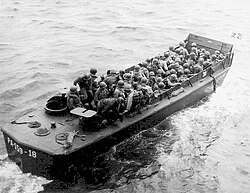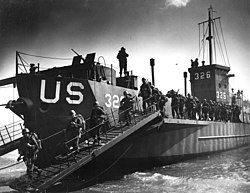Background
The United States amphibious operations dates back to the early dates of the nation. On March 3, 1776, the Continental Marines made their first amphibious landing in the Battle of Nassau on to the beaches of the Bahamas. [5] [6] While amphibious operations took place in the American Civil War, Spanish–American War, and World War I, large-scale amphibious training bases were not established till World War II. [1]
Before World War II the need for Amphibious Training Base was seen. In 1903, President Theodore Roosevelt from his experience in the Spanish-American War established a Joint Army-Navy Board in 1903, but no Amphibious Training Base came out of this. One of the first small-scale Amphibious Training took place in Culebra and Vieques, Puerto Rico at the request of the Secretary of the Navy Josephus Daniels in 1913. During World War I, the Gallipoli amphibious operations in Turkey did not go well for the Allies, thus some thought that amphibious warfare was at an end. [1]
After World War I, in which Japan fought on the Allied side, Japan took control of German bases in China and the Pacific. In 1919, the League of Nations approved Japan's mandate over the German islands north of the equator. The United States did not want any mandates and was concerned with Japan's aggressiveness. As such Wilson Administration transferred 200 Atlantic warships to the Pacific Fleet in 1919. [7] [8] [1]
With new concerns in the Pacific, in 1921, Marine Commandant Lieutenant General John A. Lejeune asked Major Earl “Pete” Ellis to make up plans for an amphibious war with Japan, as to be prepared. Ellis wrote OpPlan 712: Advance Base Operations in Micronesia, which outlined modern amphibious warfare. [9] The Fleet Marine Force was founded on December 7, 1933. Fleet Marine Force was a combined Force of both the US Navy and the United States Marine Corps. On December 7, 1941, Japan carried out a surprise military strike on the Naval Base in Pearl Harbor. [10] [11] Japan hoped to eliminate US military force in the Pacific as it soon carried out attacks across the South Pacific. [12] [13] The attack led the US to enter World War II. During World War II the United States was fighting on two fronts, the Pacific War and the European theatre. The Pacific War was an amphibious operation of Island-hopping and the European theatre required amphibious operations to get a foothold on the European continent. European theatre saw major amphibious operations at the invasion of North Africa, Southern France, Sicily, Italy and Normandy. [1]
On January 5, 1942 Seabee Navy Construction Battalions officially began operation. [14] In July 1943 Seabee started an Amphibious Construction Battalion, with Amphibious Construction Battalion 1 as the first unit, which operated in the Pacific War. Seabee were given the task of clearing beaches of obstacles and establishing beachhead bases. [15] [16] In addition, Seabees built and operated sea ports, airfields and served as elements the United States Marine Corps. [17]
This nation's first official naval amphibious training base was established in August 1942 at Solomons, Maryland, USNATB, United States Navy Amphibious Training Base. Other base opened on both coasts of the United States. [18] [19] Due to the demand for Amphibious Training, overseas bases were founded in North Africa and the South Pacific. [20] [21] [1] [22]
The United States Navy needed to train with the US Army and US Marine Corps, as amphibious landing require complex operations: [3]
- Strategic planning
- Amphibious vessels need to arrive and be loaded with all the supplies and troops needed for the operation.
- Must be reconnaissance of the landing site
- Landing site may need obstacles removed, and the water depth checked.
- Landing must be timed to the tide.
- Air cover must be timed to landing.
- Beach checked for landmines and other obstacles.
- After troops and vehicles debark, support supplies are unloaded the beachhead supply depot.
This page is based on this
Wikipedia article Text is available under the
CC BY-SA 4.0 license; additional terms may apply.
Images, videos and audio are available under their respective licenses.



















